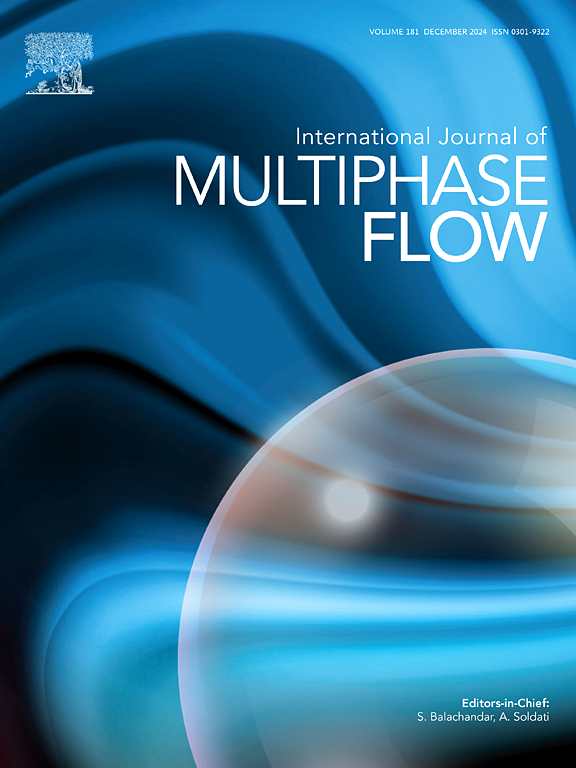Direct numerical simulation of side-by-side rising bubble coalescence behavior based on a Weber number criterion
IF 3.8
2区 工程技术
Q1 MECHANICS
International Journal of Multiphase Flow
Pub Date : 2025-10-02
DOI:10.1016/j.ijmultiphaseflow.2025.105470
引用次数: 0
Abstract
The coalescence dynamics of two bubbles rising side by side in quiescent water are investigated using direct numerical simulations based on the Volume of Fluid (VOF) method with adaptive mesh refinement (AMR), implemented on the Basilisk platform. To address the inherent issue of numerical coalescence in VOF simulations, a physically motivated criterion based on the Weber number is employed, enabling accurate distinction between coalescence and rebound events. The topology-based AMR algorithm allows resolution of micrometer-scale features of film drainage and interfacial deformation. Simulation results show excellent agreement with experimental data in terms of rise velocity, approach velocity, and collision outcomes. Three representative interaction regimes are analyzed in detail: direct-coalescence, rebound-coalescence, and rebound-separation. The results reveal that surface and wake vorticity play a central role in controlling bubble approach, deformation, and film drainage. Notably, the emergence of a double-spiral, counter-rotating vortex structure is found to induce bubble reorientation and retard film drainage, thereby governing the transition between rebound and coalescence. Energy budget analysis further indicates that rebound and separation following contact are closely linked to high bubble deformation and significant accumulation of surface energy during the approach phase. The conversion of surface energy back into kinetic energy drives the rebound and eventual separation. While viscous dissipation related to film drainage plays an important role in a direct-coalescence case, it is considerably small in the rebound and separation case, where the dissipation is mainly caused by shape oscillation and vorticity accumulation upon collision. A phase diagram is constructed to map collision outcomes as a function of bubble size and initial separation distance, highlighting the coupled effects of vortex dynamics and energy transfer and dissipation in bubble coalescence and rebound. These findings provide new insights into the hydrodynamic mechanisms underlying bubble interactions in multiphase flows and contribute to the development of more accurate coalescence models for practical and industrial applications.

基于韦伯数准则的并排上升气泡聚并行为的直接数值模拟
采用基于流体体积法(VOF)和自适应网格细化(AMR)的直接数值模拟方法,研究了静水中并排上升的两个气泡的聚并动力学。为了解决VOF模拟中固有的数值聚并问题,采用了基于韦伯数的物理动机准则,从而能够准确区分聚并和反弹事件。基于拓扑的AMR算法可以分辨出微米尺度的膜排水和界面变形特征。仿真结果表明,在上升速度、接近速度和碰撞结果等方面与实验数据吻合良好。详细分析了三种典型的相互作用机制:直接聚结、反弹-聚结和反弹-分离。结果表明,表面涡量和尾流涡量在控制气泡接近、变形和膜排水中起着核心作用。值得注意的是,双螺旋、反向旋转的涡旋结构的出现,诱导气泡重新定向,延缓薄膜排水,从而控制反弹和合并之间的转变。能量收支分析进一步表明,接触后的回弹和分离与接近阶段的高气泡变形和显著的表面能积累密切相关。表面能转化为动能驱动反弹和最终分离。在直接合并的情况下,与薄膜排水有关的粘性耗散起着重要作用,而在反弹和分离的情况下,耗散作用相当小,主要是由形状振荡和碰撞时涡量积累引起的。构建了气泡大小和初始分离距离对碰撞结果的相图,突出了气泡合并和反弹过程中涡流动力学与能量传递和耗散的耦合作用。这些发现为多相流中气泡相互作用的流体动力学机制提供了新的见解,并有助于开发更准确的实际和工业应用的聚结模型。
本文章由计算机程序翻译,如有差异,请以英文原文为准。
求助全文
约1分钟内获得全文
求助全文
来源期刊
CiteScore
7.30
自引率
10.50%
发文量
244
审稿时长
4 months
期刊介绍:
The International Journal of Multiphase Flow publishes analytical, numerical and experimental articles of lasting interest. The scope of the journal includes all aspects of mass, momentum and energy exchange phenomena among different phases such as occur in disperse flows, gas–liquid and liquid–liquid flows, flows in porous media, boiling, granular flows and others.
The journal publishes full papers, brief communications and conference announcements.

 求助内容:
求助内容: 应助结果提醒方式:
应助结果提醒方式:


